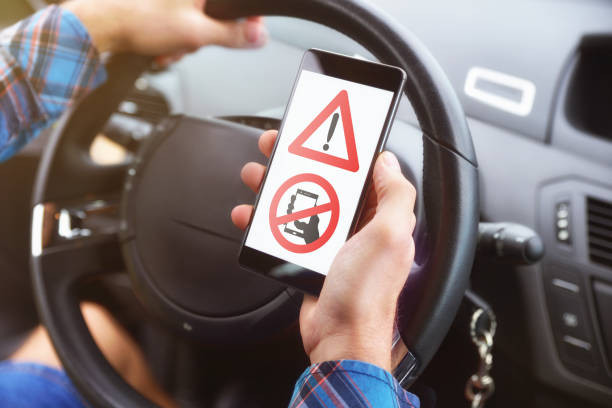Fact: Learn Why Hands-Free Devices Can Still Be Distracting
In the age of advanced technology and increasing connectivity, hands-free devices have become a common accessory for drivers. Many believe that using hands-free devices is a safe alternative to handheld ones, allowing drivers to keep their hands on the wheel and eyes on the road. However, this belief is a myth. Even hands-free devices can be a significant distraction, affecting your ability to drive safely. At Get Drivers Ed, we emphasize understanding the real impact of hands-free devices on driving safety.
The Cognitive Distraction
What Is Cognitive Distraction?
Cognitive distraction occurs when your mind is not fully focused on driving. Even though your hands are on the wheel and your eyes are on the road, your brain is engaged in a conversation or task unrelated to driving. This mental engagement takes away from the cognitive resources needed to process information from the driving environment.
Mental Load
Engaging in a conversation, even through a hands-free device, requires cognitive effort. This mental load can reduce your ability to process driving-related information. The brain's resources are finite, and when they are divided between two tasks, each task receives less attention.
Attention Split
When you use hands-free devices, your attention is divided between the conversation and the driving task, which can lead to slower reaction times and impaired decision-making. The brain's limited capacity means that it cannot fully devote itself to the driving task when it is simultaneously processing a conversation.
Studies and Statistics
Numerous studies have highlighted the risks associated with using hands-free devices while driving.
University of Utah Study
Research conducted by the University of Utah found that drivers using hands-free devices are just as distracted as those using handheld phones. The study revealed that the cognitive distraction level was similar, leading to decreased driving performance. Participants showed reduced reaction times and missed critical visual and auditory cues.
AAA Foundation for Traffic Safety
The AAA Foundation for Traffic Safety reported that using hands-free devices can delay a driver's reaction time as much as having a blood alcohol concentration at the legal limit of 0.08%. This alarming statistic underscores the significant impact of cognitive distractions on driving performance.
Real-World Implications and Scenarios
Delayed Reactions in Critical Situations
Hands-free devices can lead to dangerous situations on the road. Here are some common scenarios where hands-free device use can create hazards:
Missed Signals
While engaged in a hands-free conversation, you might miss important road signals or traffic signs, increasing the risk of accidents. For example, a driver might not notice a stop sign or a pedestrian crossing.
Delayed Reactions
Cognitive distraction can slow your reaction time, making it harder to respond to sudden changes in traffic or unexpected obstacles. This delay can be critical in preventing collisions.
Addressing Misconceptions and Overconfidence
False Sense of Security
Many drivers believe that using hands-free devices is safe, leading to overconfidence and complacency.
Overestimation of Abilities
Drivers might overestimate their ability to multitask, believing they can handle a conversation while driving. This overconfidence can result in less vigilance and increased risk. They might not realize that the cognitive load of a conversation can significantly impair their driving performance.
Legality vs. Safety
While hands-free device use is legal in many places, it does not equate to safety. Understanding the difference between legality and safety is crucial for responsible driving. Just because something is legal does not mean it is safe.
Safer Alternatives
Minimize Distractions
To ensure safer driving, it is essential to minimize all forms of distractions, including hands-free devices.
Pre-Drive Preparation
Make any necessary calls or send messages before starting your trip. Plan your route and set up navigation systems in advance. This preparation helps eliminate the need to use hands-free devices while driving.
Pull Over Safely
If you must take a call or respond to a message, pull over to a safe location first. It is better to be temporarily stationary than to risk driving distracted. Finding a safe place to stop allows you to handle calls or messages without endangering yourself or others.
Education and Awareness
Role of Drivers Ed
Driver education plays a critical role in raising awareness about the risks associated with hands-free devices.
Comprehensive Training
At Get Drivers Ed, we provide comprehensive training that covers the dangers of all forms of distracted driving, including hands-free device use. Our courses include real-life scenarios and practical exercises to help students understand and mitigate these risks.
Practical Tips
Our courses offer practical tips and strategies to help drivers stay focused on the road and minimize distractions. We emphasize the importance of planning and situational awareness to reduce reliance on hands-free devices.
Conclusion
Hands-free devices are not the safe solution many believe them to be. Cognitive distractions caused by hands-free device use can significantly impair driving performance and increase the risk of accidents. At Get Drivers Ed, we are committed to educating drivers about the real dangers of distracted driving and promoting safer driving practices.
Ready to become a safer, more informed driver? Enroll in our comprehensive online drivers ed program today. Let Get Drivers Ed provide you with the tools and knowledge necessary to drive responsibly and safely.


